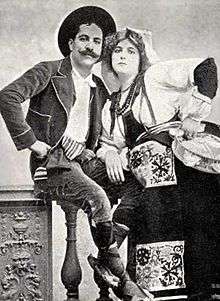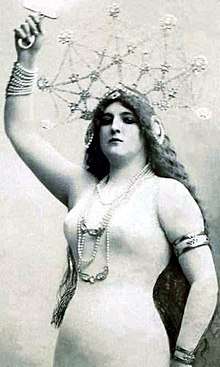Clara Ward, Princesse de Caraman-Chimay
Clara Ward (17 June 1873 – 9 December 1916) was a wealthy American socialite who married a prince from Belgium.
Clara Ward | |
|---|---|
 An English postcard from c. 1905, featuring a German chromolithograph of Clara Ward | |
| Born | June 17, 1873 Detroit, Michigan |
| Died | December 9, 1916 (aged 43) Padua, Italy |
| Nationality | American |
| Spouse(s) | Joseph, Prince de Caraman-Chimay Rigó Jancsi Peppino Ricciardo Signor Cassalota |
The story of Clara Ward, who commonly used one or another version of the title "Princesse de Caraman-Chimay", is poorly known today, but for some years in the early 1890s she was the toast of the United States. During the late 1890s and the Edwardian years, she spent much time in both the society and gossip columns of two continents. She was widely known, envied and admired, desired, loathed and reviled.
Early life
Clara Ward was born in Detroit, Michigan, the daughter of Captain Eber Brock Ward (1811–1875) and his second wife, Catherine Lyon, a niece of Senator Benjamin Wade. A wealthy man, often stated to be Michigan's first millionaire, E.B. Ward had holdings in Great Lakes steamships; lumbering at Ludington, Michigan; iron and steel manufacturing at Wyandotte, Michigan, Leland, Michigan, Milwaukee, Wisconsin, and Chicago, Illinois; and silver mining in Colorado. He manufactured the first Bessemer steel to be made in the United States at his plant in Wyandotte. Ward was president of the Flint and Pere Marquette Railroad from 1860 until his death on 2 January 1875 in Detroit.
Captain Ward died when Clara was less than two years old. The mill and timber holdings at Ludington passed into the hands of Clara's mother and were managed by her brother, Thomas R. Lyon, as the firm of Thomas R. Lyon, Agent. As a child, Clara and her mother periodically visited Ludington to see their kin and inspect the mills.
First marriage
She came to the public's attention in 1889 or early 1890, when it was announced that a distinguished Belgian visitor to the United States, the Prince of Caraman-Chimay, a member of the Belgian Chamber of Deputies, had proposed marriage to the very young, very attractive daughter of a very wealthy family.
The Château de Chimay is in the county of Hainaut, Belgium, near the French border. The holder of the title "Prince of Caraman-Chimay" did so rightfully and possessed a long and proper noble pedigree. This princely title was of the "foreign prince" type of the old French monarchy, in which "Prince" is a noble rank rather than a method showing the degree of relationship to the crown. The wife of that sort of prince becomes a "Princess", and so Clara became, entirely legitimately, a European princess. That her husband-to-be was more than twice her age, quite poor, and even, perhaps, not very handsome, seems to have been of minor consequence. They were married on 20 May 1890, in Paris. Clara was married at age 16 and her husband was 31.
Ward was now properly styled "Princesse de Caraman-Chimay", but usually went by "Clara, Princess of Chimay". Americans were ecstatic about their new princess. (The first American princess had been Catherine Willis Gray, great-grandniece of George Washington, who married a nephew of Emperor Napoleon, Prince Achille Murat of Naples, in 1826; Baltimore heiress Betsy Patterson had previously married Napoleon's brother Jérôme (later King of Westphalia) in 1803, but Napoleon annulled the marriage within a few years.) In 1891 she was the subject of a portrait by G.P.A. Healy, today in the collection of the Illinois State Museum in Springfield.
Two children shortly followed the marriage:
- Marie Elisabeth Catharine Anatole de Riquet, Comtesse de Caraman-Chimay (1891–1939)
- Marie Joseph Anatole Pierre Alphonse de Riquet, Prince de Caraman-Chimay (1894–1920)
There is evidence that she and the Prince favored the more prestigious Parisian restaurants with their patronage. Specifically, the great chef Escoffier named both Oeufs à la Chimay and Poularde Chimay after Princess Clara.
Second marriage


Some time after the birth of their second child, in early November 1896, the Prince and Princess Chimay were dining in Paris, at what may be expected to have been a suitably elegant establishment. Present at the restaurant was a Hungarian, Rigó Jancsi, who eked out a living providing Gypsy music. (Being Hungarian, "Rigó" was the gentleman's family name meaning "blackbird", and "Jancsi" his given name − it is the Hungarian version of "Johnny".) Rigó was a Gypsy violinist (he is sometimes listed as a chef but it is not true.)
After a series of secret meetings, Ward and Rigó eloped in December 1896. To her family's consternation, the Ludington Record of 24 December 1896 carried a news service dispatch about the elopement with a woodcut illustration of Ward and the headline "Gone With a Gypsy". It was stated that Prince Joseph would at once institute divorce proceedings against his wife. Subsequent editions of the newspaper carried brief notices as to where Ward and Rigó had been reported seen during their trek across Europe to Hungary. In Budapest a well-known cube-shaped chocolate sponge cake and chocolate cream pastry was named Rigo Jancsi after the scandalous affair Ward and Rigó were having. The Prince and Princesse de Caraman-Chimay were divorced on 19 January 1897. The new couple married, probably in Hungary. Some accounts indicate that they soon moved to Egypt, where Clara taught her husband the intricacies of reading and writing.
Not too surprisingly, Clara Ward, still usually called the Princess Chimay, soon found her resources dwindling. The never-very-full Chimay coffers were certainly closed to her, and although Ward was resourceful, her American family had to intervene from time to time to straighten out her tangled finances.
Her main talents were being beautiful by the standards of the time, and being famous. She combined the two by posing on various stages, including at least the Folies Bergère and probably also the Moulin Rouge, while wearing skin-tight costumes. She called her art-form her poses plastiques. Henri de Toulouse-Lautrec made a scarce lithograph of her and Rigó in 1897, "Idylle Princière". She was often photographed, and featured on many postcards during the Edwardian period, sometimes in a pose plastique and sometimes in more or less conventional dress. Kaiser Wilhelm II is said to have forbidden the publication or display of her photograph in the German Empire because he thought her beauty "disturbing".
Later life
Perhaps the income from this odd occupation was sufficient for the couple to live reasonably well. The idyll was not to last, Rigó being unfaithful to her. They were divorced fairly soon after their marriage, either shortly before or after Ward met her next love, one Peppino Ricciardo, sometimes stated to have been Spanish, but who was most likely Italian. He is believed to have been a waiter whom she met on a train.
They married in 1904, but Peppino Ricciardo probably did not last long. The timing is vague, but Ward's next love, and her last husband, is thought to have been a station manager of the little Italian railroad that helped visitors tour Mount Vesuvius, a Signor Cassalota. Ward is believed to have still been married to her fourth husband when she died in Padua, Italy, on 9 December 1916, aged 43.
It was not until some three years after Ward's death that her first husband, Prince Joseph de Riquet of Chimay and Caraman, finally remarried — to a young lady who had only been a few months old when he and Clara originally married.
Legacy
Marcel Proust was fond of Clara. This is affirmed by Marthe, Princess Bibesco, who quoted from a letter he wrote to her cousin, Antoine, that he wrote to her and - although, alas, he hadn't seen her for some years, he still liked her just as much. (My paraphrase, from Bibesco's memoir, "Au Bal avec Marcel Proust", available from Gallimard). In fact, Proust based a character in "À la recherche du temps perdu" on Clara Ward: that of a cousin of the Baron Charlus. The major character of the Duchesse de Guermantes was chiefly based on Clara Ward's first sister-in-law, Elisabeth, who became the Comtesse de Greffulhe after her marriage. The character of Simone Pistache in the film version of Cole Porter's musical Can-Can was based in part on Clara Ward. In the film, set in Paris in 1896, Shirley MacLaine as Pistache dances in a skin-tight, flesh-colored costume like that favored by Ward.
See also
- Rigo Jancsi Celebration Cake
References
- Charles Richard Tuttle, General History of the State of Michigan, pp. 157–159. Detroit: R.D.S. Tyler & Co., 1873.
- History of Manistee, Mason and Oceana Counties, Michigan, pp. 50–51. Chicago: H.R. Page & Co., 1882.
- "Gone With a Gypsy", news dispatch in the Ludington Record, December 24, 1896.
- George W. Hotchkiss, History of the Lumber and Forest Industry of the Northwest, pp. 715–716. Chicago: George W. Hotchkiss & Company, 1898.
- The National Cyclopedia of American Biography, Vol. XIII, p. 125. New York: James T. White & Company, 1906.
- Luman W. Goodenough, Lumber, Lath and Shingles, pp. 54–55. Detroit: Privately printed, 1954. Written by a childhood acquaintance of Ward's who died in 1947.
- Cleveland Amory, Who Killed Society?, p. 234. New York: Harper & Brothers, 1960.
- Cornelia Otis Skinner, Elegant Wits and Grand Horizontals, p. 220. Boston: Houghton Mifflin Company, 1962.
External links
- Prince of Chimay, history at the Wayback Machine (archived October 26, 2009)
- The Chateau of Chimay and Hainaut, Belgium
- Toulouse-Lautrec's "Idylle Princière"
- Clara Ward, Princesse de Caraman-Chimay at Find a Grave